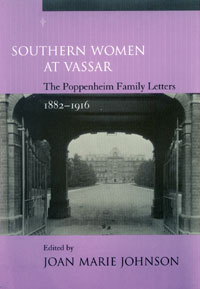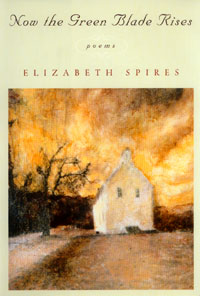About Books
Southern Women at Vassar:
The Poppenheim Family Letters 1882–1916
Edited by Joan Marie Johnson
University of South Carolina Press, 2002
It is generally known that Vassar women have a long list of historical firsts. It is not generally known that these firsts include spawning the South's women’s movement.

Johnson’s own interest in Southern women began when she left her native New Jersey for undergraduate study at Duke University. During her Ph.D. work at the University of California at Los Angeles, Johnson’s dissertation focused on black and white South Carolina women’s clubs in the early 1900s. Her book This Wonderful Dream Nation: Black and White South Carolina Women and the Creation of the New South 1898–1930 is forthcoming, and the research for this topic led Johnson to the Poppenheim sisters, the most prominent white suffragists at the time.
From 1899 until 1914, Mary and Louisa Poppenheim owned and edited the Keystone, the official organ of women’s clubs in South Carolina, particularly of the Daughters of the Confederacy. Through further research, Johnson was led to correspondence between the sisters and their mother during their college years spent at Vassar and beyond, the originals of which were located at Duke University.
“Through a women’s studies research grant for the special collections library at Duke, I was able to get Xeroxed copies of the microfilm,” Johnson explained. “So I was working with Xeroxes of microfilm of original letters and postcards, which I then transcribed,” she laughed. Johnson also spent a week at Vassar in June 1999, digging through the library’s Special Collections section. “I pored through all of these documents. Special Collections has scrapbooks, student letters, and class biographies for reunions. Classes would write long letters to the class secretaries. There was a lot of material involving the Poppenheim sisters, including original letters written well into the 1930s between the sisters and the class secretary.”
The Poppenheim girls came from an old Charleston family, and the majority of the book chronicles the sisters’ struggle with balancing their mother’s coaxing to remain Southern ladies with the progressive “Yankee” nature of Vassar. In a letter dated February 6, 1884, the girls’ mother instructed Mary how to behave in regards to the notion of suffrage: “If I were you, I would be very retiring and ladylike whenever there is any voting to be done, and avoid having any thing to do with a party that savors of women’s rights.” Only one month later, Mary wrote to her sister Louisa, who was still home preparing to make the trip to Vassar, about a party where she played fortune-teller: “And I would be a second Susan B. Anthony coming to W. [Washington] to hand a petition for women’s rights to the Pres.” It was clearly tricky for the Poppenheim sisters to honor their southern heritage while they became increasingly independent and their intellectual curiosity grew.
But the book is not entirely made up of stoic and history-laden themes. In a letter dated January 8, 1887, Mrs. Poppenheim wrote of her daughters’ absence: “I think I have darned every stocking in the home, sewn on every button, fixed the blue silk for Ida, even studied the French alphabet, and yet I cannot kill time, nor fail to miss you.” It is this relationship between the mother and her daughters that adds a timeless element to the letters.
Much of the book is also a lively look at daily Vassar life during the late 1800s, filled with antics and class rivalries. A letter from Mary to her younger sister Kitty on May 29, 1887, for example, details how the seniors locked the juniors in the Senior Corridor one night and Mary’s class came to the rescue: “When we got in, the Seniors rushed at us with window sticks and chairs and pinched, knocked down, shook and otherwise pitched into our girls. Then their president made a nice little speech where she called ’88 [the juniors] a Class of ‘Rowdys’ and they hissed at us. We were piping mad I can tell you and we sent word to them that they must apologize.”
Most important, Johnson said, is the way these letters show how the sisters changed while they were away at college. “I think education still has that ability,” she concluded.
— Kelly McMasters '98
Kelly McMasters ’98 is in her first year of M.F.A. study for creative non-fiction writing at Columbia University. She is a freelance writer living in Brooklyn, and her work has been published in Glamour, Popular Mechanics, and Time Out New York.
Now The Green Blade Rises
Poems by Elizabeth Spires ’74
W. W. Norton & Co., 2002
In the book On Longing, the poet Susan Stewart studies meticulously our need for mementos — the small, yet hungry mechanics of nostalgia. We all make our humble shrines to memory, but what provokes our cherishing of this or that framed photograph or the need to preserve that corsage in the attic? Stewart reminds us why nostalgia is a small and flawed thing.

The book’s introductory poem visits Robert Frost’s cabin. We hear in it echoes of Frost’s own poem “Directive,” and when Spires writes, “Past time is with you always, always here,” we are made very aware of time’s overlappings, of an “unceasing flow” and pervasive life-rhythm about which we can do almost nothing.
Spires has long observed the qualities of such progressions. She stands poised in these poems between a daughter on one side and her own dying mother and friends on the other. She is keenly aware of her place between and in time. Spires’ vehement awareness of the patterning calls to mind an image in the memorable poem “Glass Bottom Boat” from her third book Annonciade:
Suddenly a shadow parted the school—
as if a cloud had just blotted the sun—
a barracuda swerving as they swerved,
and nothing they could do.
After it fed, the two halves joined,
the missing ones unmourned,
all as it was before.
Spires witnesses what is awesome: the repeated display of nature’s powers and energies, but also what is profoundly perilous and fragile.
She asks many questions in the face of this riddle of time playing out its patterns. She turns to nature for what it may know, and thus contributes to our knowing — to the dogwood tree, the rock wall, mountain, lake, cloud, the tides, “The swollen moon floating in a pool,/disappearing, coming back.” Or she reprises a few lines from Homer, threads their truth into now, makes them sing again to show us what timelessness means.
Spires’ poems encourage us to bring some knowledge onward and outward from memory, from this “rushing stream of years.” In the poem “Cemetery Reef” she writes, “Everything was changing to memory.” This could mean merely more loss, grief, nostalgia — more elegies. But Spires suggests it can be more: “In these poems, I was aware of poetry as a kind of ongoing conversation — the voice or voices in the poem talking back and forth, and not just with the living.”
These poems feel often in their cadences “like the sound of time itself.”
— A.V. Christie '85
A.V. Christie’s ’85 interview with Elizabeth Spires appeared in the Southwest Review in 1995. Christie is currently Writer-in-Residence at Penn State Abington. Her first book of poems was Nine Skies (National Poetry Series, 1997).
